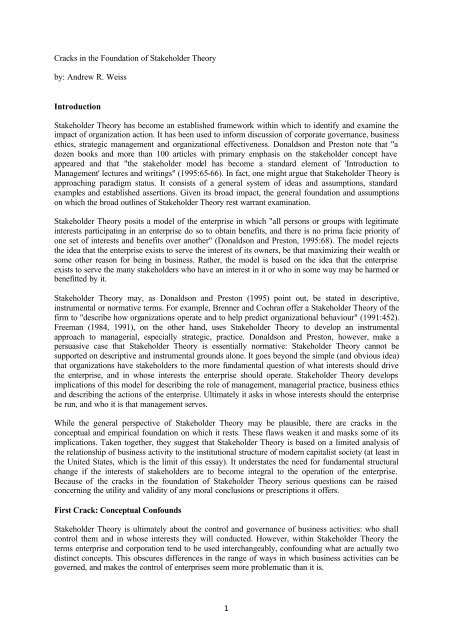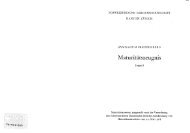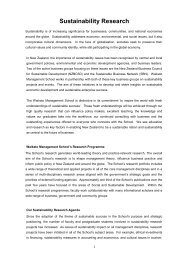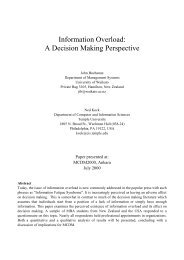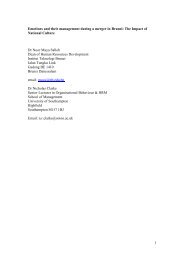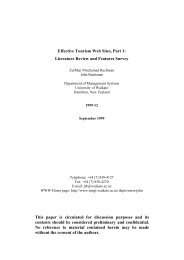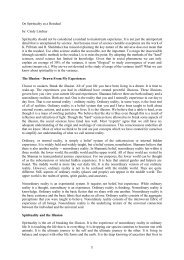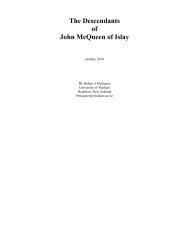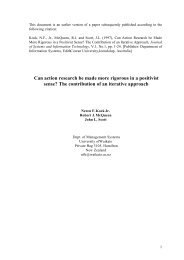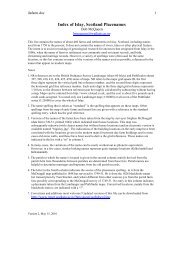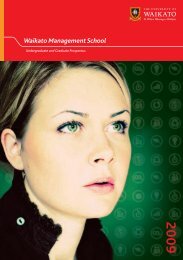Cracks in the Foundation of Stakeholder Theory by - Waikato ...
Cracks in the Foundation of Stakeholder Theory by - Waikato ...
Cracks in the Foundation of Stakeholder Theory by - Waikato ...
Create successful ePaper yourself
Turn your PDF publications into a flip-book with our unique Google optimized e-Paper software.
<strong>Cracks</strong> <strong>in</strong> <strong>the</strong> <strong>Foundation</strong> <strong>of</strong> <strong>Stakeholder</strong> <strong>Theory</strong><br />
<strong>by</strong>: Andrew R. Weiss<br />
Introduction<br />
<strong>Stakeholder</strong> <strong>Theory</strong> has become an established framework with<strong>in</strong> which to identify and exam<strong>in</strong>e <strong>the</strong><br />
impact <strong>of</strong> organization action. It has been used to <strong>in</strong>form discussion <strong>of</strong> corporate governance, bus<strong>in</strong>ess<br />
ethics, strategic management and organizational effectiveness. Donaldson and Preston note that "a<br />
dozen books and more than 100 articles with primary emphasis on <strong>the</strong> stakeholder concept have<br />
appeared and that "<strong>the</strong> stakeholder model has become a standard element <strong>of</strong> 'Introduction to<br />
Management' lectures and writ<strong>in</strong>gs" (1995:65-66). In fact, one might argue that <strong>Stakeholder</strong> <strong>Theory</strong> is<br />
approach<strong>in</strong>g paradigm status. It consists <strong>of</strong> a general system <strong>of</strong> ideas and assumptions, standard<br />
examples and established assertions. Given its broad impact, <strong>the</strong> general foundation and assumptions<br />
on which <strong>the</strong> broad outl<strong>in</strong>es <strong>of</strong> <strong>Stakeholder</strong> <strong>Theory</strong> rest warrant exam<strong>in</strong>ation.<br />
<strong>Stakeholder</strong> <strong>Theory</strong> posits a model <strong>of</strong> <strong>the</strong> enterprise <strong>in</strong> which "all persons or groups with legitimate<br />
<strong>in</strong>terests participat<strong>in</strong>g <strong>in</strong> an enterprise do so to obta<strong>in</strong> benefits, and <strong>the</strong>re is no prima facie priority <strong>of</strong><br />
one set <strong>of</strong> <strong>in</strong>terests and benefits over ano<strong>the</strong>r" (Donaldson and Preston, 1995:68). The model rejects<br />
<strong>the</strong> idea that <strong>the</strong> enterprise exists to serve <strong>the</strong> <strong>in</strong>terest <strong>of</strong> its owners, be that maximiz<strong>in</strong>g <strong>the</strong>ir wealth or<br />
some o<strong>the</strong>r reason for be<strong>in</strong>g <strong>in</strong> bus<strong>in</strong>ess. Ra<strong>the</strong>r, <strong>the</strong> model is based on <strong>the</strong> idea that <strong>the</strong> enterprise<br />
exists to serve <strong>the</strong> many stakeholders who have an <strong>in</strong>terest <strong>in</strong> it or who <strong>in</strong> some way may be harmed or<br />
benefitted <strong>by</strong> it.<br />
<strong>Stakeholder</strong> <strong>Theory</strong> may, as Donaldson and Preston (1995) po<strong>in</strong>t out, be stated <strong>in</strong> descriptive,<br />
<strong>in</strong>strumental or normative terms. For example, Brenner and Cochran <strong>of</strong>fer a <strong>Stakeholder</strong> <strong>Theory</strong> <strong>of</strong> <strong>the</strong><br />
firm to "describe how organizations operate and to help predict organizational behaviour" (1991:452).<br />
Freeman (1984, 1991), on <strong>the</strong> o<strong>the</strong>r hand, uses <strong>Stakeholder</strong> <strong>Theory</strong> to develop an <strong>in</strong>strumental<br />
approach to managerial, especially strategic, practice. Donaldson and Preston, however, make a<br />
persuasive case that <strong>Stakeholder</strong> <strong>Theory</strong> is essentially normative: <strong>Stakeholder</strong> <strong>Theory</strong> cannot be<br />
supported on descriptive and <strong>in</strong>strumental grounds alone. It goes beyond <strong>the</strong> simple (and obvious idea)<br />
that organizations have stakeholders to <strong>the</strong> more fundamental question <strong>of</strong> what <strong>in</strong>terests should drive<br />
<strong>the</strong> enterprise, and <strong>in</strong> whose <strong>in</strong>terests <strong>the</strong> enterprise should operate. <strong>Stakeholder</strong> <strong>Theory</strong> develops<br />
implications <strong>of</strong> this model for describ<strong>in</strong>g <strong>the</strong> role <strong>of</strong> management, managerial practice, bus<strong>in</strong>ess ethics<br />
and describ<strong>in</strong>g <strong>the</strong> actions <strong>of</strong> <strong>the</strong> enterprise. Ultimately it asks <strong>in</strong> whose <strong>in</strong>terests should <strong>the</strong> enterprise<br />
be run, and who it is that management serves.<br />
While <strong>the</strong> general perspective <strong>of</strong> <strong>Stakeholder</strong> <strong>Theory</strong> may be plausible, <strong>the</strong>re are cracks <strong>in</strong> <strong>the</strong><br />
conceptual and empirical foundation on which it rests. These flaws weaken it and masks some <strong>of</strong> its<br />
implications. Taken toge<strong>the</strong>r, <strong>the</strong>y suggest that <strong>Stakeholder</strong> <strong>Theory</strong> is based on a limited analysis <strong>of</strong><br />
<strong>the</strong> relationship <strong>of</strong> bus<strong>in</strong>ess activity to <strong>the</strong> <strong>in</strong>stitutional structure <strong>of</strong> modern capitalist society (at least <strong>in</strong><br />
<strong>the</strong> United States, which is <strong>the</strong> limit <strong>of</strong> this essay). It understates <strong>the</strong> need for fundamental structural<br />
change if <strong>the</strong> <strong>in</strong>terests <strong>of</strong> stakeholders are to become <strong>in</strong>tegral to <strong>the</strong> operation <strong>of</strong> <strong>the</strong> enterprise.<br />
Because <strong>of</strong> <strong>the</strong> cracks <strong>in</strong> <strong>the</strong> foundation <strong>of</strong> <strong>Stakeholder</strong> <strong>Theory</strong> serious questions can be raised<br />
concern<strong>in</strong>g <strong>the</strong> utility and validity <strong>of</strong> any moral conclusions or prescriptions it <strong>of</strong>fers.<br />
First Crack: Conceptual Confounds<br />
<strong>Stakeholder</strong> <strong>Theory</strong> is ultimately about <strong>the</strong> control and governance <strong>of</strong> bus<strong>in</strong>ess activities: who shall<br />
control <strong>the</strong>m and <strong>in</strong> whose <strong>in</strong>terests <strong>the</strong>y will conducted. However, with<strong>in</strong> <strong>Stakeholder</strong> <strong>Theory</strong> <strong>the</strong><br />
terms enterprise and corporation tend to be used <strong>in</strong>terchangeably, confound<strong>in</strong>g what are actually two<br />
dist<strong>in</strong>ct concepts. This obscures differences <strong>in</strong> <strong>the</strong> range <strong>of</strong> ways <strong>in</strong> which bus<strong>in</strong>ess activities can be<br />
governed, and makes <strong>the</strong> control <strong>of</strong> enterprises seem more problematic than it is.<br />
1
The concept <strong>of</strong> <strong>the</strong> enterprise is simple: it is permanent commercial establishment that takes various<br />
<strong>in</strong>puts and transforms <strong>the</strong>m <strong>in</strong>to products or services. An enterprise comes <strong>in</strong>to be<strong>in</strong>g when an<br />
<strong>in</strong>dividual or group <strong>of</strong> <strong>in</strong>dividuals set out to engage <strong>in</strong> some economic activity. That <strong>the</strong>y do so is<br />
simply a matter <strong>of</strong> personal goals and <strong>the</strong> enterprise is a vehicle for achiev<strong>in</strong>g what ever goals <strong>the</strong>y<br />
br<strong>in</strong>g to it. They use <strong>the</strong>ir own resources (f<strong>in</strong>ancial capital, human capital, <strong>the</strong>ir own labour) to achieve<br />
<strong>the</strong>se goals. In <strong>the</strong> process <strong>the</strong>y create a stream <strong>of</strong> activities which <strong>the</strong>y control because <strong>the</strong>se activities<br />
use resources that <strong>the</strong>y have purchased and own. For <strong>the</strong> same reason, <strong>the</strong>y own <strong>the</strong> outputs <strong>of</strong> <strong>the</strong><br />
enterprise and may dispose <strong>of</strong> <strong>the</strong>m as <strong>the</strong>y see fit (constra<strong>in</strong>ed only <strong>by</strong> law and custom, and <strong>the</strong>ir own<br />
values). They may enter <strong>in</strong>to agreements with o<strong>the</strong>r <strong>in</strong>dividuals to provide supplies, money or labour<br />
power to be used <strong>in</strong> <strong>the</strong> course <strong>of</strong> do<strong>in</strong>g bus<strong>in</strong>ess (this assumes, <strong>of</strong> course, that labour power is a<br />
commodity, which is a controversial assumption <strong>in</strong> some circles, but a necessary and accepted aspect<br />
<strong>of</strong> a capitalist economy).<br />
The activities that characterize an enterprise result <strong>in</strong> transactions that are organized <strong>by</strong> markets and<br />
systems <strong>of</strong> law and regulation. These transactions represent one k<strong>in</strong>d <strong>of</strong> relationship between <strong>the</strong><br />
enterprise and <strong>in</strong>dividuals or o<strong>the</strong>r enterprises. In <strong>the</strong> course <strong>of</strong> do<strong>in</strong>g bus<strong>in</strong>ess, <strong>the</strong> enterprise also<br />
affects <strong>in</strong>dividuals and enterprises <strong>in</strong>directly: it produces harms and benefits, some <strong>of</strong> <strong>the</strong>se are not<br />
<strong>in</strong>cluded <strong>in</strong> <strong>the</strong> prices for <strong>the</strong> goods bought and sold--what Coase (1961) called externalities.<br />
<strong>Stakeholder</strong> <strong>Theory</strong>, on <strong>the</strong> o<strong>the</strong>r hand, def<strong>in</strong>es <strong>the</strong> enterprise as an "entity through which numerous<br />
and diverse participants accomplish multiple, and not always congruent, purposes (Donaldson and<br />
Preston, 1995: 70). This confuses <strong>the</strong> enterprise and <strong>the</strong> <strong>in</strong>terests <strong>of</strong> its owners with those parties with<br />
whom it <strong>in</strong>teracts directly or <strong>in</strong>directly. <strong>Stakeholder</strong>s are any persons or groups that are harmed or<br />
benefited <strong>by</strong>, and so have a legitimate <strong>in</strong>terest <strong>in</strong>, <strong>the</strong> enterprise. Consequently, <strong>the</strong>y have a legitimate<br />
stake <strong>in</strong> how <strong>the</strong> enterprise runs and a claim on its control. They have a right to divert some <strong>of</strong> <strong>the</strong><br />
benefits away for <strong>the</strong> owners and to be protected from harm.<br />
<strong>Stakeholder</strong> <strong>Theory</strong> <strong>of</strong>ten presents <strong>the</strong> enterprise as a nexus <strong>of</strong> <strong>in</strong>terests, what Brummer (1991:16)<br />
called a "web <strong>of</strong> private agreements". The image <strong>of</strong> <strong>the</strong> enterprise as a web obscures <strong>the</strong> fact that it is<br />
owners <strong>of</strong> <strong>the</strong> enterprise and not <strong>the</strong> enterprise itself, who are at <strong>the</strong> centre <strong>of</strong> <strong>the</strong> web. They are <strong>the</strong><br />
one party common to all <strong>in</strong>teractions with, and effects on, o<strong>the</strong>r parties. It misses <strong>the</strong> po<strong>in</strong>t that <strong>the</strong>re<br />
are no o<strong>the</strong>r <strong>in</strong>terests <strong>in</strong> <strong>the</strong> activities <strong>of</strong> <strong>the</strong> enterprise until it comes <strong>in</strong>to existence and its owners enter<br />
<strong>in</strong>to agreements with o<strong>the</strong>r parties or create externalities. <strong>Stakeholder</strong> <strong>Theory</strong> confuses <strong>the</strong> enterprise<br />
with <strong>the</strong> relationships that form, and <strong>in</strong>teractions that occur, <strong>in</strong> course <strong>of</strong> do<strong>in</strong>g bus<strong>in</strong>ess.<br />
The actions <strong>of</strong> <strong>the</strong> enterprise have consequences, <strong>in</strong>tended and un<strong>in</strong>tended, which can cause harms and<br />
benefits to <strong>the</strong> parties directly <strong>in</strong>volved with it and to <strong>by</strong>standers. Someone must be morally and<br />
legally responsible for <strong>the</strong>se consequences. As a stream <strong>of</strong> activities or a set <strong>of</strong> resources <strong>the</strong> enterprise<br />
cannot be responsible <strong>in</strong> moral terms: only a human be<strong>in</strong>g can be a moral agent. Moral responsibility<br />
lies with <strong>the</strong> people who create and control <strong>the</strong> enterprise, directly or through agents who work for<br />
<strong>the</strong>m and <strong>in</strong> <strong>the</strong>ir name.<br />
By that same logic, an enterprise itself cannot enter <strong>in</strong>to contracts, own property, be sued or hire<br />
employees. Such activities are limited to what <strong>the</strong> law refers to as "legal persons:" persons who have<br />
legal rights def<strong>in</strong>ed with<strong>in</strong> a system <strong>of</strong> social and economic <strong>in</strong>stitutions. Not all people <strong>in</strong> a society are<br />
necessarily persons <strong>in</strong> <strong>the</strong> full legal sense. Until recently, some people were denied <strong>the</strong> full legal status<br />
as persons as m<strong>in</strong>or children still are.<br />
On <strong>the</strong> o<strong>the</strong>r hand, not all legal persons are people. The corporation is a legal device <strong>in</strong> which a<br />
fictitious person is created which has <strong>the</strong> legal stand<strong>in</strong>g to engage <strong>in</strong> economic and legal transactions.<br />
Creat<strong>in</strong>g a corporation provides a way to pool, organize and govern <strong>the</strong> use <strong>of</strong> resources that are<br />
privately owned <strong>by</strong> a number <strong>of</strong> people. It makes it possible for a group <strong>of</strong> people (a company) to<br />
conduct bus<strong>in</strong>ess as a s<strong>in</strong>gle legal entity. The corporation is a legal person and has many <strong>of</strong> <strong>the</strong><br />
specific rights <strong>of</strong> an <strong>in</strong>dividual. It <strong>in</strong> turn is owned <strong>by</strong> its stockholders who control it through a board<br />
2
<strong>of</strong> directors and <strong>of</strong>ficers. A corporation is created (<strong>in</strong> <strong>the</strong> United States, at least; o<strong>the</strong>r countries have<br />
different approaches) <strong>by</strong> <strong>in</strong>dividuals through a rout<strong>in</strong>e application to a state government.<br />
Incorporation is a contrivance. It is a legal device that makes it easier and more convenient for people<br />
to do what <strong>the</strong>y can already do as <strong>in</strong>dividuals, exercis<strong>in</strong>g rights <strong>the</strong>y already have. The primary value<br />
<strong>of</strong> <strong>in</strong>corporation is that <strong>the</strong> fictitious person can nom<strong>in</strong>ally be a party to a contract, hold title to<br />
property or engage <strong>in</strong> transactions. This makes it unnecessary for all <strong>of</strong> <strong>the</strong> owners <strong>of</strong> an enterprise to<br />
directly <strong>in</strong>volved <strong>in</strong> all actions undertaken <strong>in</strong> course <strong>of</strong> do<strong>in</strong>g bus<strong>in</strong>ess. Over <strong>the</strong> years, governments<br />
have provided some <strong>in</strong>centives to corporations, especially <strong>in</strong> grant<strong>in</strong>g special tax status and limit<strong>in</strong>g<br />
<strong>the</strong> liability <strong>of</strong> owners <strong>in</strong> torts to <strong>the</strong>ir total <strong>in</strong>vestment <strong>in</strong> <strong>the</strong> enterprise, <strong>in</strong> order to facilitate <strong>the</strong><br />
conduct <strong>of</strong> bus<strong>in</strong>ess, but this has not changed <strong>the</strong> nature or status <strong>of</strong> <strong>the</strong> corporation. In fact, <strong>the</strong>re is<br />
virtually noth<strong>in</strong>g that a corporation does that could not be done <strong>by</strong> <strong>in</strong>dividuals through a series <strong>of</strong><br />
contracts and <strong>in</strong>formal agreements.<br />
Incorporation does not confer an especially privileged status on, or change <strong>the</strong> nature <strong>of</strong> <strong>the</strong> enterprise.<br />
The control <strong>by</strong> owners <strong>of</strong> <strong>the</strong> enterprise and <strong>the</strong>ir moral responsibility for <strong>the</strong> consequences <strong>of</strong> its<br />
activities are not changed <strong>by</strong> <strong>in</strong>corporation. The corporation is <strong>the</strong> creature <strong>of</strong> its owners and provides<br />
a legal <strong>in</strong>termediary between <strong>the</strong> owners and <strong>the</strong> enterprise. It serves as a surrogate for <strong>the</strong> owners as<br />
<strong>the</strong> nom<strong>in</strong>al party to transactions and contracts. However, it cannot be a moral agent because it is not a<br />
human be<strong>in</strong>g. The moral responsibility for <strong>the</strong> enterprise passes through <strong>the</strong> corporation and rests with<br />
its owners.<br />
Contracts and less formal but stable understand<strong>in</strong>gs between an enterprise and o<strong>the</strong>r parties (see<br />
Weiss, 1982 for a discussion <strong>of</strong> such understand<strong>in</strong>gs) represent ways <strong>of</strong> reduc<strong>in</strong>g transactions costs<br />
between <strong>the</strong> enterprise and o<strong>the</strong>r parties <strong>by</strong> regulariz<strong>in</strong>g what would o<strong>the</strong>rwise require a series <strong>of</strong><br />
ongo<strong>in</strong>g market <strong>in</strong>teractions and negotiations. It is <strong>the</strong> owners whose <strong>in</strong>terests are reflected <strong>in</strong> <strong>the</strong><br />
enterprise's side <strong>of</strong> <strong>the</strong> contract or understand<strong>in</strong>g. O<strong>the</strong>r parties to direct <strong>in</strong>teractions, contracts or<br />
understand<strong>in</strong>gs negotiate rights, compensation for harms and payments for benefits that <strong>the</strong>y will<br />
receive as terms <strong>of</strong> <strong>the</strong> contract or understand<strong>in</strong>g. As participants <strong>in</strong> markets, specific transactions<br />
reflect negotiations <strong>in</strong> which parties are assumed to be voluntary participants. To be sure, <strong>the</strong>se<br />
negotiations may be unfair--one party may have more power than o<strong>the</strong>rs. The enterprise may be <strong>the</strong><br />
weaker party, especially when it is small relative to <strong>the</strong> market or community with<strong>in</strong> which <strong>the</strong><br />
negotiation occurs. However, this is a question <strong>of</strong> <strong>the</strong> structure <strong>of</strong> particular markets and does not alter<br />
<strong>the</strong> conventional model <strong>of</strong> <strong>the</strong> enterprise.<br />
The problem <strong>of</strong> externalities still exists, <strong>of</strong> course. Protect<strong>in</strong>g people from or compensat<strong>in</strong>g <strong>the</strong>m for<br />
<strong>the</strong> <strong>in</strong>direct harms caused <strong>by</strong> <strong>the</strong> actions <strong>of</strong> an enterprise requires processes that go beyond <strong>the</strong> market<br />
such as regulation and legal action, but this doesn't change <strong>the</strong> issue <strong>of</strong> legal or moral responsibility <strong>of</strong><br />
owners. The moral responsibility for <strong>the</strong>se harms rests with <strong>the</strong> owners <strong>of</strong> <strong>the</strong> enterprise or <strong>the</strong><br />
corporation. There is noth<strong>in</strong>g <strong>the</strong> conventional view <strong>of</strong> <strong>the</strong> enterprise, or <strong>in</strong> <strong>the</strong> nature <strong>of</strong> capitalism,<br />
that would relieve owners <strong>of</strong> <strong>the</strong> moral obligation to obey <strong>the</strong> law or to take responsibility for <strong>the</strong><br />
consequences <strong>of</strong> <strong>the</strong>ir actions.<br />
Contracts and agreements may be negotiated and executed <strong>by</strong> <strong>the</strong> owners <strong>of</strong> an enterprise or <strong>by</strong> agents<br />
who act <strong>in</strong> <strong>the</strong>ir name and <strong>in</strong> <strong>the</strong>ir <strong>in</strong>terest. Even if <strong>the</strong> owners empower agents to negotiate for <strong>the</strong>m or<br />
to operate <strong>the</strong> enterprise <strong>in</strong> <strong>the</strong>ir name, contracts and agreements still exist between <strong>the</strong> owners and<br />
o<strong>the</strong>r parties. This is also <strong>the</strong> case <strong>in</strong> corporations where <strong>the</strong>re are multiple owners and an <strong>in</strong>termediate<br />
structure (<strong>the</strong> corporation itself): <strong>the</strong> pr<strong>in</strong>cipal-agent relationship stays <strong>the</strong> same, and <strong>the</strong> owners bear<br />
responsibility for <strong>the</strong> consequences <strong>of</strong> <strong>the</strong> actions <strong>of</strong> <strong>the</strong> enterprise. This is not to say that agents<br />
always act as <strong>the</strong>ir pr<strong>in</strong>cipals would have <strong>the</strong>m act. Agency <strong>the</strong>ory (c.f., Jensen, 1989; Jensen and<br />
Mechl<strong>in</strong>g, 1976) exam<strong>in</strong>es <strong>the</strong> problems <strong>of</strong> ma<strong>in</strong>ta<strong>in</strong><strong>in</strong>g control over agents who may act <strong>in</strong> <strong>the</strong>ir own<br />
<strong>in</strong>terests ra<strong>the</strong>r than <strong>in</strong> <strong>the</strong> <strong>in</strong>terest <strong>of</strong> <strong>the</strong>ir pr<strong>in</strong>cipals, but it starts from <strong>the</strong> assumption that agents are<br />
expected to represent <strong>the</strong>ir pr<strong>in</strong>ciples. The underly<strong>in</strong>g assumption <strong>of</strong> agency <strong>the</strong>ory is that <strong>the</strong> legal<br />
rights <strong>of</strong> owners and <strong>the</strong>ir moral responsibility rema<strong>in</strong>s at <strong>the</strong> centre <strong>of</strong> <strong>the</strong> enterprise.<br />
3
<strong>Stakeholder</strong> <strong>Theory</strong> confuses <strong>the</strong> person who conducts bus<strong>in</strong>ess (<strong>the</strong> owners or <strong>the</strong> corporation as <strong>the</strong><br />
creature <strong>of</strong> its owners) with <strong>the</strong> conduct <strong>of</strong> bus<strong>in</strong>ess itself (<strong>the</strong> enterprise). It confuses <strong>the</strong> parties to <strong>the</strong><br />
actions <strong>of</strong> <strong>the</strong> enterprise with <strong>the</strong> owners <strong>of</strong> <strong>the</strong> enterprise. While see<strong>in</strong>g <strong>the</strong> enterprise as a nexus <strong>of</strong><br />
<strong>in</strong>terests, it fails to note that <strong>the</strong> owner or corporation and not <strong>the</strong> enterprise is always one <strong>of</strong> <strong>the</strong><br />
parties to <strong>the</strong> contract, that <strong>the</strong> <strong>in</strong>terests <strong>of</strong> <strong>the</strong> owners are always one side <strong>of</strong> <strong>the</strong> conrtact, and that an<br />
enterprise as a stream <strong>of</strong> activities or <strong>the</strong> corporation as a fictitious legal person cannot a moral agent:<br />
it is <strong>the</strong> owners who are <strong>the</strong> moral agents.<br />
Second Crack: <strong>the</strong> Idea <strong>of</strong> A Social Contract for Bus<strong>in</strong>ess<br />
In some forms <strong>of</strong> <strong>Stakeholder</strong> <strong>Theory</strong>, it is argued (although more <strong>of</strong>ten implicitly assumed) that <strong>the</strong>re<br />
exists a social contract between bus<strong>in</strong>ess and society that provides a moral basis for <strong>the</strong> social control<br />
<strong>of</strong> bus<strong>in</strong>ess activity. <strong>Stakeholder</strong> <strong>Theory</strong> tends to assume that <strong>the</strong> actions <strong>of</strong> enterprises can be legally<br />
and morally constra<strong>in</strong>ed, and that moral (ra<strong>the</strong>r than merely legal) obligations can be placed on<br />
corporations because bus<strong>in</strong>ess is a creature <strong>of</strong> society. Donaldson articulates this with <strong>the</strong> assertion<br />
that "What productive organizations need from society is:<br />
Recognition as a s<strong>in</strong>gle agent, especially <strong>in</strong> <strong>the</strong> eyes <strong>of</strong> <strong>the</strong> law, and<br />
The authority:<br />
(a) to own or use land and natural resources, and<br />
(b) to hire employees" (1982:43).<br />
He goes on to argue that because productive organizations require (and receive) specia l status under<br />
<strong>the</strong> law and use society's resources, <strong>the</strong>y can be morally obligated to serve <strong>the</strong> public <strong>in</strong>terest.<br />
For <strong>Stakeholder</strong> <strong>Theory</strong> to be valid, this claim on <strong>the</strong> enterprise must be a moral obligation <strong>in</strong> order to<br />
legitimate <strong>the</strong> claims <strong>of</strong> stakeholders. <strong>Stakeholder</strong> <strong>Theory</strong> does this <strong>by</strong> claim<strong>in</strong>g a prior, implicit social<br />
agreement exists to which all members <strong>of</strong> society are parties. It provides a response to <strong>the</strong> argument<br />
that <strong>the</strong> <strong>in</strong>terests <strong>of</strong> stakeholders who are directly <strong>in</strong>volved with <strong>the</strong> activities <strong>of</strong> an enterprise are<br />
already taken <strong>in</strong>to account because <strong>the</strong>y are engaged <strong>in</strong> voluntary transactions. It also allows<br />
<strong>Stakeholder</strong> <strong>Theory</strong> to identify and legitimate <strong>the</strong> <strong>in</strong>terests <strong>of</strong> stakeholders who are not directly<br />
<strong>in</strong>volved, such as communities, who may be affected <strong>in</strong>directly as a consequence <strong>of</strong> <strong>the</strong> activities <strong>of</strong> an<br />
enterprise. Their stakes are legitimated because society grants <strong>the</strong> enterprise <strong>the</strong> right to exist.<br />
But, as Donaldson concedes, <strong>in</strong>dividuals already have <strong>the</strong> rights needed to create an enterprise. They<br />
need no special provision (except, perhaps, <strong>in</strong> some cases were a licence is required) to operate a<br />
specific bus<strong>in</strong>ess. It is a consequence <strong>of</strong> <strong>the</strong> <strong>in</strong>terwoven <strong>in</strong>stitutions <strong>of</strong> capitalist society that <strong>in</strong>dividual<br />
has all <strong>the</strong> rights necessary to establish an enterprise, to own property, to make th<strong>in</strong>gs alone or hire<br />
o<strong>the</strong>rs to work and to create a company <strong>of</strong> people, an organisation, to produce, manage, to buy<br />
supplies, sell what is made, with no additional recognition from society. If <strong>the</strong>re is a social contract for<br />
bus<strong>in</strong>ess <strong>in</strong> a capitalist society, it lies <strong>in</strong> <strong>the</strong> provision <strong>of</strong> rights and <strong>in</strong>stitutional arrangements that<br />
support <strong>the</strong> creation <strong>of</strong> enterprises.<br />
<strong>Stakeholder</strong> <strong>Theory</strong> tends to ignore <strong>the</strong> fact that <strong>the</strong>re is already a social contract for bus<strong>in</strong>ess <strong>in</strong><br />
contemporary society which <strong>in</strong>cludes what might be called <strong>the</strong> m<strong>in</strong>imalist morality <strong>of</strong> modern<br />
capitalism: moral obligations to obey <strong>the</strong> law, honour contracts and agreements and respect <strong>the</strong> rights<br />
(<strong>in</strong>clud<strong>in</strong>g property rights) <strong>of</strong> o<strong>the</strong>rs. The ideology <strong>of</strong> capitalism asserts that economic value is<br />
produced <strong>by</strong> owners who, hav<strong>in</strong>g deferred consumption, have taken <strong>the</strong>ir sav<strong>in</strong>gs and put <strong>the</strong>m to<br />
productive use <strong>in</strong> ways that are available to any o<strong>the</strong>r member <strong>of</strong> society. They <strong>the</strong>refore have an<br />
exclusive moral claim to <strong>the</strong> benefits produced <strong>by</strong> <strong>the</strong>ir activities.<br />
4
<strong>Stakeholder</strong> <strong>Theory</strong> does not provide an alternative answer to <strong>the</strong> question <strong>of</strong> who, or what, produces<br />
economic value. Its focus is on <strong>the</strong> distribution <strong>of</strong> <strong>the</strong> outcomes, <strong>the</strong> harms and benefits, and not on<br />
who produced <strong>the</strong> harms and benefits. It assumes value is produced <strong>by</strong> <strong>the</strong> enterprise itself and that<br />
stakeholders have a claim on some <strong>of</strong> this value because <strong>the</strong> enterprise is a creature <strong>of</strong> society.<br />
The social contract <strong>of</strong> modern capitalist society does not require <strong>the</strong> k<strong>in</strong>d <strong>of</strong> attention to <strong>the</strong> <strong>in</strong>terests <strong>of</strong><br />
all stakeholders that <strong>Stakeholder</strong> <strong>Theory</strong> envisions. It assumes that capitalists produce value, that all<br />
transactions are voluntary and that people can take legal action to recover damages <strong>in</strong> <strong>the</strong> case <strong>of</strong><br />
harms caused <strong>by</strong> o<strong>the</strong>rs. The moral responsibility <strong>of</strong> <strong>the</strong> owner <strong>of</strong> a bus<strong>in</strong>ess is that <strong>of</strong> any <strong>in</strong>dividual <strong>in</strong><br />
society. A m<strong>in</strong>imalist morality may or may not be adequate from some moral perspectives but it is <strong>the</strong><br />
basic moral framework <strong>of</strong> modern capitalism. The <strong>in</strong>stitutional structure <strong>of</strong> modern capitalism is<br />
rooted <strong>in</strong> an ideological system that legitimates <strong>the</strong> actions <strong>of</strong> creat<strong>in</strong>g an enterprise and conduct<strong>in</strong>g<br />
bus<strong>in</strong>ess, as well as claim<strong>in</strong>g <strong>the</strong> value produced, with<strong>in</strong> its own moral system.<br />
The claim that bus<strong>in</strong>ess has a special, dist<strong>in</strong>ct moral status cannot be derived from <strong>the</strong> nature <strong>of</strong> <strong>the</strong><br />
enterprise, or from <strong>the</strong> nature <strong>of</strong> <strong>the</strong> corporation. <strong>Stakeholder</strong> <strong>Theory</strong> makes implicitly <strong>the</strong> assumption<br />
that Donaldson makes explicit: <strong>the</strong> enterprise has a dist<strong>in</strong>ct, privileged social status. As a result, it<br />
claims a moral justification for limit<strong>in</strong>g <strong>the</strong> rights <strong>of</strong> owners, and import<strong>in</strong>g <strong>the</strong> <strong>in</strong>terests <strong>of</strong><br />
stakeholders <strong>in</strong> to <strong>the</strong> operation <strong>of</strong> <strong>the</strong> enterprise. This is <strong>in</strong>consistent with <strong>the</strong> arrangement <strong>of</strong> <strong>the</strong><br />
<strong>in</strong>stitutions <strong>of</strong> modern capitalism, <strong>in</strong>stitutions that legitimate <strong>the</strong> right <strong>of</strong> owners to control <strong>the</strong><br />
enterprise and use it for <strong>the</strong>ir own, private purposes. With<strong>in</strong> <strong>the</strong> moral structure <strong>of</strong> capitalism this is<br />
accepted as moral behaviour.<br />
Third Crack: <strong>the</strong> General Applicability <strong>of</strong> <strong>Stakeholder</strong> <strong>Theory</strong><br />
<strong>Stakeholder</strong> <strong>Theory</strong> grounds its vie w <strong>of</strong> <strong>the</strong> moral issues surround<strong>in</strong>g <strong>the</strong> enterprise <strong>in</strong> <strong>the</strong> issue <strong>of</strong> <strong>the</strong><br />
control and governance <strong>of</strong> large corporations. It rout<strong>in</strong>ely, and uncritically, builds on <strong>the</strong> argument<br />
advanced <strong>by</strong> Berle and Means (1932) that ownership and control are separated <strong>in</strong> modern<br />
corporations. Berle and Means argued that <strong>the</strong> rise <strong>of</strong> pr<strong>of</strong>essional managers and <strong>the</strong> grow<strong>in</strong>g size and<br />
stability <strong>of</strong> stock markets had led to a situation where corporations were owned <strong>by</strong> large numbers <strong>of</strong><br />
stockholders who held small amounts <strong>of</strong> stock. These owners became <strong>in</strong>creas<strong>in</strong>gly disengaged from<br />
<strong>the</strong> runn<strong>in</strong>g <strong>of</strong> <strong>the</strong> enterprise and control <strong>of</strong> <strong>the</strong> corporation, be<strong>in</strong>g content to <strong>in</strong>vest <strong>in</strong> or sell shares <strong>in</strong><br />
<strong>the</strong> corporation response to its f<strong>in</strong>ancial performance. <strong>Stakeholder</strong> <strong>Theory</strong> argues that because<br />
ownership is diffuse, <strong>the</strong> property rights and moral agency <strong>of</strong> owners are <strong>in</strong>creas<strong>in</strong>gly irrelevant. This<br />
opens <strong>the</strong> way for fur<strong>the</strong>r legitimat<strong>in</strong>g <strong>the</strong> claims <strong>of</strong> stakeholders aga<strong>in</strong>st those <strong>of</strong> owners.<br />
Proponents <strong>of</strong> <strong>the</strong> Berle and Means hypo<strong>the</strong>ses extend <strong>the</strong> argument <strong>by</strong> po<strong>in</strong>t<strong>in</strong>g out that <strong>in</strong>stitutional<br />
<strong>in</strong>vestors have substantial hold<strong>in</strong>gs <strong>in</strong> <strong>the</strong> equity <strong>in</strong> publicly traded firms. They own 45.6% <strong>of</strong> all<br />
equity and 57.1% <strong>of</strong> <strong>the</strong> largest 1000 companies. It is widely assumed that such <strong>in</strong>vestors do not<br />
engage <strong>in</strong> <strong>the</strong> affairs <strong>of</strong> <strong>the</strong> corporations <strong>in</strong> which <strong>the</strong>y own stock, preferr<strong>in</strong>g to simply sell <strong>the</strong>ir shares<br />
if <strong>the</strong> stock does not perform as <strong>the</strong>y like, leav<strong>in</strong>g management a free hand to establish <strong>the</strong> goals and<br />
priorities <strong>of</strong> <strong>the</strong> corporation. Two recent articles <strong>in</strong> <strong>the</strong> Wall Street Journal (1995a, 1995b) outl<strong>in</strong><strong>in</strong>g<br />
aggressive actions taken <strong>by</strong> <strong>in</strong>stitutional <strong>in</strong>vestors seek<strong>in</strong>g to maximize return on stockholder wealth<br />
attest to <strong>the</strong>ir <strong>in</strong>terest <strong>in</strong>, and ability to <strong>in</strong>fluence <strong>the</strong> management <strong>of</strong> <strong>the</strong> corporations <strong>in</strong> which <strong>the</strong>y<br />
own stock. Pension funds and o<strong>the</strong>r <strong>in</strong>stitutions are vot<strong>in</strong>g <strong>the</strong>ir shares and <strong>in</strong>terven<strong>in</strong>g <strong>in</strong> management<br />
to fur<strong>the</strong>r <strong>the</strong>ir <strong>in</strong>terests as owners. Clearly, <strong>the</strong>re are a number <strong>of</strong> large corporations <strong>in</strong> which<br />
management is able to exercise control with little <strong>in</strong>volvement <strong>of</strong> stockholders, but this is not always<br />
<strong>the</strong> case <strong>in</strong> even <strong>the</strong> largest publicly held corporations, and is certa<strong>in</strong>ly not <strong>the</strong> case <strong>in</strong> <strong>the</strong> vast number<br />
<strong>of</strong> enterprises. It is not possible to simply assert that stockholders are rout<strong>in</strong>ely disengaged from <strong>the</strong><br />
control <strong>of</strong> even very large corporations.<br />
Because <strong>Stakeholder</strong> <strong>Theory</strong> does not make a clear dist<strong>in</strong>ction between enterprise and corporation, it<br />
dramatically overstates <strong>the</strong> separation <strong>of</strong> ownership and control, generaliz<strong>in</strong>g from corporations to all<br />
enterprises. It doesn't acknowledge that <strong>the</strong> Berle and Means argument, at best, can only apply to <strong>the</strong><br />
relatively small number <strong>of</strong> very large corporations <strong>in</strong> which ownership is publicly traded. However,<br />
5
<strong>the</strong>re were about 20 million bus<strong>in</strong>ess establishments <strong>in</strong> <strong>the</strong> United States <strong>in</strong> 1990. Of <strong>the</strong>se, 3,717,000<br />
were legally organized as corporations, 1,554,000 were partnerships and 14,783,000 were sole<br />
proprietorships (Statistical Abstract <strong>of</strong> <strong>the</strong> United States, 1994:539). On <strong>the</strong> o<strong>the</strong>r hand, <strong>the</strong>re are<br />
roughly ten thousand corporations (two tenths <strong>of</strong> one percent <strong>of</strong> all corporations) <strong>in</strong> which ownership<br />
shares are publicly traded corporations. In all but <strong>the</strong>se ten thousand corporations, owners are ei<strong>the</strong>r<br />
directly <strong>in</strong>volved with management or personally know <strong>the</strong> managers and control <strong>of</strong> <strong>the</strong> enterprise is<br />
directly tied to ownership: <strong>the</strong> owners are close to bus<strong>in</strong>ess and can impose <strong>the</strong>ir <strong>in</strong>terests on it.<br />
It could be argued that <strong>the</strong> patterns <strong>of</strong> control <strong>in</strong> large publicly traded corporations should be taken as a<br />
model because <strong>the</strong>y represent <strong>the</strong> bulk <strong>of</strong> economic activity. It is true that <strong>the</strong> publicly traded<br />
corporations account for about 75% <strong>of</strong> <strong>the</strong> American Gross Domestic Product (GDP). With <strong>the</strong> 500<br />
largest <strong>in</strong>dustrial corporations account<strong>in</strong>g for about 19% <strong>of</strong> total sales <strong>in</strong> <strong>the</strong> United States (Statistical<br />
Abstract <strong>of</strong> <strong>the</strong> United States, 1994:559). However, <strong>the</strong>se numbers can be mislead<strong>in</strong>g: <strong>the</strong>y represent<br />
f<strong>in</strong>al goods. That is, <strong>the</strong> contribution to GDP and <strong>the</strong> reports <strong>of</strong> total sales represented <strong>by</strong> <strong>the</strong>se large<br />
enterprises <strong>in</strong>cludes <strong>the</strong> economic output <strong>of</strong> <strong>the</strong> many o<strong>the</strong>r, smaller bus<strong>in</strong>esses that supply <strong>the</strong>m with<br />
<strong>in</strong>puts. The sales <strong>of</strong> <strong>the</strong>se <strong>in</strong>termediate goods, are not counted <strong>in</strong> GDP or reports <strong>of</strong> total revenues.<br />
These measures <strong>of</strong> <strong>the</strong> relative size <strong>of</strong> <strong>the</strong> economic role <strong>of</strong> <strong>the</strong> largest corporations cannot be taken to<br />
mean that <strong>the</strong>y are <strong>the</strong> primary actors <strong>in</strong> <strong>the</strong> American economy.<br />
Ano<strong>the</strong>r way to look at this is to note that employment is heavily skewed toward small enterprises.<br />
N<strong>in</strong>ety two million people were employed <strong>in</strong> <strong>the</strong> United States <strong>in</strong> 1990 with a total payroll <strong>of</strong> $2,145<br />
billion. Only 12 million (13%) <strong>of</strong> <strong>the</strong>se were employed <strong>in</strong> enterprises with more than 1000 employees<br />
while 50 million (54%) were employed <strong>in</strong> enterprises with fewer than 100 employees. Only 6000<br />
employers (which could be no more than 60% <strong>of</strong> publicly traded corporations) had more than 1000<br />
employees and <strong>the</strong>se accounted for payrolls <strong>of</strong> $390 billion. (Statistical Abstract <strong>of</strong> <strong>the</strong> United States,<br />
1994:546). Clearly, most people are employed <strong>by</strong> small enterprises which must be produc<strong>in</strong>g<br />
sufficient economic value to justify <strong>the</strong> number <strong>of</strong> people <strong>the</strong>y employ and <strong>the</strong> payrolls <strong>the</strong>y carry.<br />
While large publicly traded corporations represent an important part <strong>of</strong> <strong>the</strong> economy, <strong>the</strong>y cannot be<br />
taken as a representative model for all enterprises <strong>in</strong> <strong>the</strong> United States, or capitalist economies <strong>in</strong><br />
general. The nature <strong>of</strong> corporate governance <strong>in</strong> <strong>the</strong>se enterprises tells us noth<strong>in</strong>g about <strong>the</strong> governance<br />
or control <strong>of</strong> enterprises <strong>in</strong> which a small number <strong>of</strong> owners are <strong>in</strong> control.<br />
Because <strong>Stakeholder</strong> <strong>Theory</strong> generally accepts <strong>the</strong> Berle and Means hypo<strong>the</strong>sis uncritically, it tends to<br />
generalize from <strong>the</strong> peculiar, even anomalous, conditions faced <strong>by</strong> a small percent <strong>of</strong> <strong>the</strong> enterprises,<br />
<strong>in</strong>appropriately tak<strong>in</strong>g <strong>the</strong>m as a model for <strong>the</strong> enterprise <strong>in</strong> general. If <strong>the</strong> separation <strong>of</strong> ownersiph<br />
and control is limited to a relatively small number <strong>of</strong> large publicly held corporations, any general<br />
<strong>the</strong>ory <strong>of</strong> governance, bus<strong>in</strong>ess ethics or corporate responsibility based on it would misrepresent <strong>the</strong><br />
nature <strong>of</strong> <strong>the</strong> control <strong>of</strong> bus<strong>in</strong>ess. The breakdown <strong>in</strong> control <strong>by</strong> owners <strong>in</strong> some (but <strong>by</strong> no means all)<br />
<strong>of</strong> very largest corporations may have important political, legal and economic implications but if<br />
cannot be argued that it has occurred most enterprises or that it is a structural feature <strong>of</strong> <strong>the</strong> modern<br />
economy, as <strong>Stakeholder</strong> <strong>Theory</strong> implicitly assumes: most enterprises, <strong>in</strong>deed most corporations, have<br />
clearly identified owners who directly or <strong>in</strong>directly control <strong>the</strong>ir activities and set <strong>the</strong> objectives for <strong>the</strong><br />
enterprise. It is <strong>the</strong>ir <strong>in</strong>terests that drive <strong>the</strong> enterprise, and it is <strong>the</strong>y who have moral obligations to<br />
those with whom <strong>the</strong>y do bus<strong>in</strong>ess and to those who are harmed or benefited <strong>in</strong>directly <strong>by</strong><br />
externalities.<br />
Fourth Crack: Ownership and Property Rights<br />
Donaldson and Preston (1995) argue that <strong>the</strong> justification for <strong>Stakeholder</strong> <strong>Theory</strong> as an implicitly or<br />
explicitly normative model rests on <strong>the</strong> validity <strong>of</strong> <strong>the</strong> owners' claims to property rights. Even if<br />
<strong>Stakeholder</strong> <strong>Theory</strong> is limited to <strong>the</strong> problem <strong>of</strong> governance and control <strong>in</strong> large corporations (or, if<br />
<strong>the</strong> large corporation is taken as a model, for o<strong>the</strong>r forms <strong>of</strong> bus<strong>in</strong>ess ownership) <strong>the</strong> problem <strong>of</strong> moral<br />
justification <strong>of</strong> <strong>Stakeholder</strong> <strong>Theory</strong> turns on <strong>the</strong> idea that maximiz<strong>in</strong>g stockholder wealth or o<strong>the</strong>r<br />
6
<strong>in</strong>terests <strong>of</strong> owners cannot morally be taken as more privileged than <strong>the</strong> <strong>in</strong>terests <strong>of</strong> o<strong>the</strong>rs who have a<br />
stake <strong>in</strong> <strong>the</strong> enterprise. This requires argu<strong>in</strong>g that <strong>the</strong> claims <strong>of</strong> stakeholders on <strong>the</strong> enterprise are<br />
legitimate <strong>in</strong> <strong>the</strong> sense that <strong>the</strong>y have comparable status to <strong>the</strong> claims <strong>of</strong> owners. The moral status <strong>of</strong><br />
<strong>the</strong>se claims and <strong>the</strong> moral obligation to honour <strong>the</strong>m turns on <strong>the</strong> relative strength and legitimacy <strong>of</strong><br />
<strong>the</strong> owners' claims based on <strong>the</strong>ir assertion <strong>of</strong> property rights: if <strong>the</strong>ir property rights are legitimate,<br />
<strong>the</strong>n <strong>the</strong> owners have priority over <strong>the</strong> claims <strong>of</strong> o<strong>the</strong>rs. <strong>Stakeholder</strong> <strong>Theory</strong> argues that <strong>the</strong> property<br />
rights <strong>of</strong> owners are erod<strong>in</strong>g, and <strong>the</strong>refore that <strong>the</strong>re are multiple legitimate claims on <strong>the</strong> enterprise,<br />
none <strong>of</strong> which have priority over any o<strong>the</strong>r.<br />
<strong>Stakeholder</strong> <strong>Theory</strong> requires that <strong>the</strong> <strong>in</strong>terests <strong>of</strong> owners be limited <strong>by</strong> <strong>the</strong> claims <strong>of</strong> o<strong>the</strong>rs to control<br />
over and benefits from an enterprise. This is a straight forward claim on <strong>the</strong> property <strong>of</strong> owners:<br />
<strong>Stakeholder</strong> <strong>Theory</strong>, <strong>in</strong> effect, creates alternative claims on <strong>the</strong> right to use and benefit from property<br />
<strong>of</strong> owners. <strong>Stakeholder</strong> <strong>Theory</strong> can be morally justified only if <strong>the</strong> rights <strong>of</strong> owners can be shown to be<br />
limited. Donaldson and Preston make this po<strong>in</strong>t explicitly and argue that <strong>the</strong>se claims are legitimate<br />
because <strong>the</strong> rights <strong>of</strong> owners rest on a weak legal and philosophical justification.<br />
Donaldson and Preston (1995) base a critique <strong>of</strong> owners' property rights, <strong>in</strong> part, on a number <strong>of</strong><br />
observations about recent legal developments. They note that Cochran and Wartick suggest that<br />
"courts have been chipp<strong>in</strong>g away at" (1988:24) <strong>the</strong> Bus<strong>in</strong>ess Judgement Rule which specifies <strong>the</strong><br />
conventional responsibilities and duties <strong>of</strong> directors, and that Orts (1992) reviews anti-take-over and<br />
constituency laws passed <strong>in</strong> several states which state that directors may (note <strong>the</strong> use <strong>of</strong> <strong>the</strong> word<br />
"may") take <strong>the</strong> <strong>in</strong>terests <strong>of</strong> parties o<strong>the</strong>r than stockholders <strong>in</strong>to account <strong>in</strong> mak<strong>in</strong>g bus<strong>in</strong>ess decisions.<br />
The implications <strong>of</strong> <strong>the</strong>se judicial and legislative <strong>in</strong>novations for an understand<strong>in</strong>g <strong>of</strong> <strong>the</strong> status <strong>of</strong> <strong>the</strong><br />
property rights <strong>of</strong> owners is actually quite limited. They largely reflect a response to <strong>the</strong> corporate<br />
takeover activity and <strong>the</strong> plant clos<strong>in</strong>gs that occurred <strong>in</strong> <strong>the</strong> 1970's and 1980's, and can only<br />
mean<strong>in</strong>gfully apply to large enterprises organized as corporations which have publicly traded stock,<br />
and a large number <strong>of</strong> stockholders. Fur<strong>the</strong>rmore, <strong>the</strong>se laws, do not require that directors consider any<br />
<strong>in</strong>terests o<strong>the</strong>r than stockholders: <strong>the</strong>y merely allow directors to consider o<strong>the</strong>r <strong>in</strong>terests when <strong>the</strong>y<br />
make specific decisions. Such laws have only limited applicability to <strong>the</strong> conventional idea <strong>of</strong><br />
ownership, and only limited relevance even to <strong>the</strong> largest corporations. In general, under exist<strong>in</strong>g law,<br />
<strong>the</strong> directors <strong>of</strong> corporations are still expected to serve <strong>the</strong> <strong>in</strong>terests <strong>of</strong> stockholders. Clark (1985:71)<br />
po<strong>in</strong>ts out, "Case law...can be fairly read to say that <strong>the</strong> manager has an affirmative, open-ended duty<br />
to maximize <strong>the</strong> beneficiaries' wealth, regardless <strong>of</strong> whe<strong>the</strong>r this is specified <strong>in</strong> any actual contract."<br />
There is no question that when owners or stockholders are <strong>in</strong> control, <strong>the</strong>ir <strong>in</strong>terests will be decisive.<br />
Donaldson and Preston also raise a philosophical question about <strong>the</strong> status <strong>of</strong> property rights as <strong>the</strong>y<br />
apply to owners. As <strong>the</strong>y po<strong>in</strong>t out, Coase (1961) and Honore (1961) argue that ownership is a<br />
complex bundle <strong>of</strong> rights, some <strong>of</strong> which may be limited: ownership is not an unrestricted right<br />
(Donaldson and Preston, 1995:83). But Honore also notes that <strong>the</strong> rights and restrictions on ownership<br />
vary across societies. Becker (1978) argues that are alternative <strong>the</strong>ories <strong>of</strong> property and shows that <strong>in</strong><br />
<strong>the</strong> twentieth century philosophers have moved toward pluralistic <strong>the</strong>ories <strong>of</strong> property which hold that,<br />
<strong>in</strong> general, property rights can be derived from a number <strong>of</strong> perspectives. But he also argues that <strong>the</strong>re<br />
are alternative ideas <strong>of</strong> what constitutes property and that <strong>the</strong>se will be associated with different ideas<br />
about <strong>the</strong> rights associated with ownership. Becker concludes that <strong>the</strong> implication <strong>of</strong> pluralistic<br />
<strong>the</strong>ories <strong>of</strong> property is that <strong>the</strong> concept <strong>of</strong> ownership is philosophically robust. At <strong>the</strong> same time, he<br />
makes it clear that <strong>the</strong> idea <strong>of</strong> ownership is embedded <strong>in</strong> specific economic and political structures.<br />
That is, while <strong>in</strong> <strong>the</strong> abstract, property can be defended on a number <strong>of</strong> grounds, <strong>in</strong> any specific social<br />
sett<strong>in</strong>g, what counts as property and <strong>the</strong> rights associated with property with be def<strong>in</strong>ed and<br />
legitimated <strong>by</strong> particular socially embedded practices and ideas.<br />
One implication <strong>of</strong> contemporary <strong>the</strong>ories <strong>of</strong> property is that ownership is a social <strong>in</strong>stitution<br />
embedded <strong>in</strong> a complex system <strong>of</strong> ideas, values and o<strong>the</strong>r <strong>in</strong>stitutions. The legal and social concept <strong>of</strong><br />
ownership is central to and cannot be separated from <strong>the</strong> <strong>in</strong>stitutional structure <strong>of</strong> capitalist society and<br />
pr<strong>in</strong>ciples such as rights <strong>of</strong> free association, freedom <strong>of</strong> contract, systems <strong>of</strong> law and <strong>in</strong>stitutionalized<br />
markets, particularly <strong>in</strong> <strong>the</strong> American variety <strong>of</strong> capitalism. The specific rights <strong>of</strong> ownership are<br />
7
historically and socially rooted <strong>in</strong> ideas <strong>of</strong> property that must be understood <strong>in</strong> <strong>the</strong> specific context <strong>of</strong><br />
modern capitalism. <strong>Stakeholder</strong> <strong>Theory</strong> treats ownership as an isolated and abstract idea divorced from<br />
this political and economic context. The crucial po<strong>in</strong>t that <strong>Stakeholder</strong> <strong>Theory</strong> attempts to work<br />
around is that, as Brummer states, ownership grounds <strong>the</strong> status <strong>of</strong> stockholders, and def<strong>in</strong>es <strong>the</strong><br />
legitimacy <strong>of</strong> management (1991:157). In modern capitalist economies, ownership rights clearly<br />
<strong>in</strong>volve <strong>the</strong> ability to control <strong>the</strong> property and determ<strong>in</strong>e (with<strong>in</strong> socially and legally established<br />
constra<strong>in</strong>ts) <strong>the</strong> use <strong>of</strong> that property, and <strong>the</strong> ends to which it will be put: that is cle arly up to <strong>the</strong><br />
owners (who rema<strong>in</strong> firmly <strong>in</strong> control <strong>of</strong> <strong>the</strong> enterprise, even <strong>in</strong> most large corporations). It is <strong>the</strong><br />
moral and legal basis for <strong>the</strong> ability <strong>of</strong> managers to act as agents and is what (at least <strong>in</strong> pr<strong>in</strong>ciple and<br />
under <strong>the</strong> law) provides for <strong>the</strong> control and accountability <strong>of</strong> managers, and it is what connects <strong>the</strong><br />
enterprise to moral agents.<br />
Donaldson and Preston assert that "<strong>the</strong> most prom<strong>in</strong>ent alternative to <strong>the</strong> <strong>Stakeholder</strong> <strong>Theory</strong> (i.e. <strong>the</strong><br />
management serv<strong>in</strong>g <strong>the</strong> shareholders' <strong>the</strong>ory) is morally untenable" (1995:88) because <strong>of</strong> <strong>the</strong> erosion<br />
<strong>of</strong> ownership rights allows <strong>the</strong> alternative claims <strong>of</strong> stakeholders to be defended as morally legitimate.<br />
By confound<strong>in</strong>g <strong>the</strong> nature <strong>of</strong> corporations and <strong>the</strong> enterprise and generaliz<strong>in</strong>g from a small number <strong>of</strong><br />
firms, <strong>the</strong>y <strong>of</strong>fer a caricature <strong>of</strong> <strong>the</strong> ownership. The exclusive claims on <strong>the</strong> enterprise <strong>by</strong> its owners<br />
are morally justified because <strong>the</strong>y have used <strong>the</strong>ir own property to create <strong>the</strong> enterprise and <strong>the</strong><br />
economic value represented <strong>by</strong> its outputs. This argument may be wrong, but with<strong>in</strong> <strong>the</strong> <strong>in</strong>stitutional<br />
context <strong>of</strong> capitalism and its moral structure, <strong>the</strong> argument <strong>of</strong>fers a plausible moral defense <strong>of</strong> <strong>the</strong><br />
conventional view <strong>of</strong> <strong>the</strong> enterprise.<br />
Fifth Crack: An Ideological Defense <strong>of</strong> A Pr<strong>of</strong>essional-Managerial Class<br />
If <strong>the</strong> property rights <strong>of</strong> owners are repudiated, obviat<strong>in</strong>g <strong>the</strong>ir predom<strong>in</strong>ant right to def<strong>in</strong>e and control<br />
<strong>the</strong> enterprise, its managers (at least <strong>in</strong> enterprises where <strong>the</strong>y not are not <strong>the</strong> owners) would be<br />
effectively left <strong>in</strong> control. The legitimacy <strong>of</strong> <strong>the</strong>ir right to be <strong>in</strong> control, and <strong>the</strong> legitimacy <strong>of</strong> any<br />
authority <strong>the</strong>y exercise over <strong>the</strong> enterprise, would be derived from a stakeholder model <strong>of</strong> <strong>the</strong><br />
enterprise. The rejection <strong>of</strong> <strong>the</strong> conventional rights <strong>of</strong> owners, which <strong>in</strong> <strong>Stakeholder</strong> <strong>Theory</strong> justifies<br />
does <strong>the</strong> claims <strong>of</strong> stakeholders on <strong>the</strong> enterprise, would also legitimate <strong>the</strong> control <strong>of</strong> <strong>the</strong> enterprise <strong>by</strong><br />
management, and establish its <strong>in</strong>dependence <strong>of</strong> identify<strong>in</strong>g, respond<strong>in</strong>g to, balanc<strong>in</strong>g and mediat<strong>in</strong>g<br />
among <strong>the</strong> <strong>in</strong>terests <strong>of</strong> different stakeholders.<br />
At one time, <strong>the</strong>re was hope that pr<strong>of</strong>essional managers could transcend <strong>the</strong> narrow <strong>in</strong>terests <strong>of</strong><br />
capitalism. Veblen (1904) believed that eng<strong>in</strong>eers (among whom he numbered managers) would<br />
eventually take control <strong>of</strong> <strong>in</strong>dustry, free<strong>in</strong>g it from <strong>the</strong> pecuniary <strong>in</strong>terests <strong>of</strong> owners who were<br />
prevent<strong>in</strong>g it from be<strong>in</strong>g fully productive. Berle and Means (1932) argued that pr<strong>of</strong>essional managers,<br />
separated from <strong>the</strong> social class <strong>in</strong>terests <strong>of</strong> owners would put <strong>the</strong> general social <strong>in</strong>terest above that <strong>of</strong><br />
mere pr<strong>of</strong>it. In <strong>the</strong>se cases, <strong>of</strong> course, <strong>the</strong> authors made explicit arguments to support <strong>the</strong> assertion that<br />
if pr<strong>of</strong>essionals were <strong>in</strong> control, bus<strong>in</strong>ess would be governed with a eye towards <strong>the</strong> general social<br />
good, ra<strong>the</strong>r than <strong>the</strong> immediate pr<strong>of</strong>its <strong>of</strong> owners.<br />
In <strong>the</strong> conventional model <strong>of</strong> <strong>the</strong> enterprise, <strong>the</strong> only moral or legal legitimacy <strong>of</strong> management is<br />
rooted <strong>in</strong> <strong>the</strong>ir role as agents <strong>of</strong> owners regardless <strong>of</strong> how much autonomy <strong>the</strong>y are given <strong>by</strong> <strong>the</strong>ir<br />
pr<strong>in</strong>cipals. If managerial authority is not grounded <strong>in</strong> ownership, <strong>the</strong>re is a serious question <strong>of</strong> what<br />
would legitimate <strong>the</strong>ir authority. It would require an ideology that legitimates <strong>the</strong>ir claims to <strong>the</strong> right<br />
to control resources and determ<strong>in</strong>e what <strong>in</strong>terests are valid <strong>in</strong> particular cases.<br />
<strong>Stakeholder</strong> <strong>Theory</strong> as it is generally discussed provides an implicit ideology that defends <strong>in</strong>creas<strong>in</strong>g<br />
<strong>the</strong> power <strong>of</strong> a particular k<strong>in</strong>d <strong>of</strong> manager; those who work <strong>in</strong> large adm<strong>in</strong>istrative structures <strong>in</strong><br />
bus<strong>in</strong>ess, non-pr<strong>of</strong>it organizations and government and identify with o<strong>the</strong>r managers as members <strong>of</strong> a<br />
pr<strong>of</strong>essional ra<strong>the</strong>r than with <strong>the</strong> organizations with<strong>in</strong> which, and <strong>the</strong> owners <strong>by</strong> whom, <strong>the</strong>y are<br />
employed. These managers are members <strong>of</strong> what Ehrenreich and Ehrenreich identified as<br />
Pr<strong>of</strong>essional-Managerial Class, a self-conscious class <strong>of</strong> people whose <strong>in</strong>terests are antagonistic to <strong>the</strong><br />
<strong>in</strong>terests <strong>of</strong> both capitalists, (that is to say <strong>the</strong> owners <strong>of</strong> enterprises) and workers (1979: 42). These<br />
8
managers are part <strong>of</strong> what Gouldner (1979: 7) called <strong>the</strong> New Class: an "elitist and self-seek<strong>in</strong>g [class]<br />
that uses its special knowledge to advance its own <strong>in</strong>terests and power, and control its own work<br />
situation."<br />
<strong>Stakeholder</strong> <strong>Theory</strong> <strong>of</strong>fers a way to articulate <strong>the</strong> <strong>in</strong>terests <strong>of</strong> members <strong>of</strong> this class, legitimate its<br />
claims to authority and establish its autonomy from o<strong>the</strong>r <strong>in</strong>stitutions <strong>in</strong> society. By <strong>in</strong>vok<strong>in</strong>g <strong>the</strong><br />
<strong>in</strong>terests <strong>of</strong> a wide range <strong>of</strong> vaguely def<strong>in</strong>ed stakeholders who are to be served <strong>by</strong> an enterprise run <strong>in</strong><br />
<strong>the</strong>ir <strong>in</strong>terest <strong>by</strong> its managers, <strong>the</strong> managers can claim to be serv<strong>in</strong>g <strong>the</strong> general <strong>in</strong>terests <strong>of</strong> society <strong>in</strong><br />
<strong>the</strong> name <strong>of</strong> <strong>the</strong> public good. As an ideology, <strong>Stakeholder</strong> <strong>Theory</strong> can be used to defend a manager's<br />
<strong>in</strong>terpretation <strong>of</strong> <strong>the</strong> merits <strong>of</strong> claims made <strong>by</strong> compet<strong>in</strong>g stakeholders and deflect critiques <strong>of</strong><br />
managerial power and prerogatives. There is no <strong>in</strong>strumentality to review managerial decisions if<br />
management concludes that some action is <strong>in</strong> <strong>the</strong> best <strong>in</strong>terests <strong>of</strong> stakeholders <strong>in</strong> general, even if it<br />
harms some specific stakeholders.<br />
There is, <strong>of</strong> course, no reason to assume that pr<strong>of</strong>essional managers would be more likely to behave<br />
more altruistically than owners, union <strong>of</strong>ficials or government bureaucrats, nor is it clear that it would<br />
be reasonable to entrust one class <strong>of</strong> people with such power. Donaldson and Preston (1995:123) note<br />
that Orts sees <strong>the</strong> possibility that constituency statues may provide managers with <strong>the</strong> opportunity to<br />
act <strong>in</strong> <strong>the</strong>ir own <strong>in</strong>terests while claim<strong>in</strong>g to serve those <strong>of</strong> stakeholders. Donaldson and Preston<br />
(1995:87) are less concerned, po<strong>in</strong>t<strong>in</strong>g out that <strong>the</strong> foundation <strong>of</strong> <strong>the</strong> stakeholder model <strong>the</strong>y have<br />
advanced "prohibits any undue attention to <strong>the</strong> <strong>in</strong>terests <strong>of</strong> any s<strong>in</strong>gle constituency." But this leaves<br />
<strong>Stakeholder</strong> <strong>Theory</strong> with a circular argument, s<strong>in</strong>ce managers would be, <strong>in</strong> effect, <strong>the</strong> only people<br />
associated with <strong>the</strong> enterprise who are <strong>in</strong> a position to decide what constitutes undue attention.<br />
<strong>Stakeholder</strong> <strong>Theory</strong> <strong>in</strong> Light <strong>of</strong> <strong>the</strong> <strong>Cracks</strong><br />
Donaldson and Preston argue persuasively that <strong>the</strong> ultimate acceptance <strong>of</strong> <strong>Stakeholder</strong> <strong>Theory</strong> rests on<br />
<strong>the</strong> validity <strong>of</strong> its normative justifications: <strong>the</strong>y conclude that <strong>the</strong> descriptive and <strong>in</strong>strumental<br />
arguments for <strong>the</strong> justification <strong>of</strong> <strong>Stakeholder</strong> <strong>Theory</strong> are not sufficient to warrant accept<strong>in</strong>g it. The<br />
problems identified here suggest that <strong>the</strong> same could be said <strong>of</strong> <strong>the</strong> normative justification and that<br />
<strong>Stakeholder</strong> <strong>Theory</strong> might be too limited and its foundation too weak to be considered ei<strong>the</strong>r useful or<br />
valid.<br />
As a normative model, <strong>the</strong> <strong>Stakeholder</strong> <strong>Theory</strong> is limited to situations where ownership is weak. At<br />
best, this would limit <strong>Stakeholder</strong> <strong>Theory</strong> to a very small number <strong>of</strong> very large corporations. The<br />
model <strong>of</strong> <strong>the</strong> enterprise and its control <strong>of</strong>fered <strong>by</strong> <strong>Stakeholder</strong> <strong>Theory</strong> is <strong>in</strong>consistent with <strong>the</strong> overall<br />
<strong>in</strong>stitutional structure <strong>of</strong> capitalism; it treats <strong>the</strong> enterprise as an isolated phenomenon. It fails to note<br />
that modern capitalism has it own moral framework, tied up with an overarch<strong>in</strong>g ideology that<br />
legitimates all <strong>of</strong> <strong>the</strong> <strong>in</strong>stitutions with<strong>in</strong> which it operates.<br />
If <strong>Stakeholder</strong> <strong>Theory</strong> is <strong>of</strong>fered as an <strong>in</strong>strumental model without its normative dimension and its<br />
rejection <strong>the</strong> control <strong>by</strong> <strong>the</strong> enterprise <strong>of</strong> owners, it simply restates a recurr<strong>in</strong>g <strong>the</strong>me <strong>in</strong> organizational<br />
<strong>the</strong>ory go<strong>in</strong>g back to Evan's (1966) discussion <strong>of</strong> <strong>the</strong> organization set, to o<strong>the</strong>r <strong>the</strong>ories <strong>of</strong> <strong>in</strong>terorganizational<br />
relations, to Peters and Waterman's (1982) excellent companies and to Porter's (1980)<br />
ideas <strong>of</strong> <strong>in</strong>dustry structure and competitive strategy. It is not controversial to argue that enterprises will<br />
be more effective (what ever that might mean <strong>in</strong> a particular case) if <strong>the</strong>y are responsive to <strong>the</strong>ir<br />
environments. If <strong>the</strong> enterprise is <strong>in</strong> <strong>the</strong> hands <strong>of</strong> <strong>the</strong> owners and stockholders, (and <strong>the</strong> evidence is that<br />
is <strong>in</strong> most cases) <strong>the</strong>n <strong>the</strong>ir goals rema<strong>in</strong> central to def<strong>in</strong><strong>in</strong>g <strong>the</strong> behaviour <strong>of</strong> <strong>the</strong> enterprise. They may<br />
choose to take <strong>the</strong> <strong>in</strong>terests <strong>of</strong> stakeholders <strong>in</strong>to account, to negotiate with <strong>the</strong>m, even put <strong>the</strong>m on <strong>the</strong><br />
board because <strong>the</strong>y conclude that it will enhance performance or because <strong>the</strong>y are morally committed<br />
to a greater social good. But a stakeholder approach to management <strong>of</strong> this k<strong>in</strong>d would not represent a<br />
departure from <strong>the</strong> ma<strong>in</strong>stream <strong>of</strong> organisation and management <strong>the</strong>ory.<br />
If, as Donaldson and Preston argue, <strong>Stakeholder</strong> <strong>Theory</strong> <strong>in</strong>tends, implicitly or explicitly, to add a<br />
particular normative dimension to our th<strong>in</strong>k<strong>in</strong>g about <strong>the</strong> enterprise, it does not succeed. It denies <strong>the</strong><br />
9
moral validity <strong>of</strong> <strong>the</strong> control <strong>of</strong> <strong>the</strong> enterprise <strong>by</strong> owners, despite <strong>the</strong>ir well established property rights<br />
and justifies creat<strong>in</strong>g new claims without <strong>of</strong>fer<strong>in</strong>g an adequate alternative <strong>the</strong>ory <strong>of</strong> <strong>the</strong> nature and<br />
validity <strong>of</strong> <strong>the</strong>se claims. It suggests that <strong>the</strong> enterprise has a moral obligation to a diverse set <strong>of</strong><br />
compet<strong>in</strong>g stakeholders, but does not <strong>of</strong>fer a framework <strong>in</strong> which to dist<strong>in</strong>guish among compet<strong>in</strong>g<br />
claims. It dismisses <strong>the</strong> control <strong>of</strong> owners, but puts pr<strong>of</strong>essional managers <strong>in</strong> control and legitimates<br />
<strong>the</strong>ir autonomy and control <strong>of</strong> <strong>the</strong> enterprise. It asserts a moral agenda, but it <strong>in</strong>vites managers to<br />
violate obligations that <strong>the</strong>y have taken on voluntarily.<br />
<strong>Stakeholder</strong> <strong>Theory</strong> suffers from an <strong>in</strong>complete analysis <strong>of</strong> <strong>the</strong> <strong>in</strong>stitutions and ideology <strong>of</strong> a modern<br />
political economy, and <strong>the</strong> relationship <strong>of</strong> <strong>the</strong> enterprise to it. It tends to treat basic <strong>in</strong>stitutions like<br />
property rights as if <strong>the</strong>y could be separated out from o<strong>the</strong>r <strong>in</strong>stitutions. It takes too much for granted,<br />
but fails to engage <strong>the</strong> possibility that capitalist society has its own moral structure.<br />
Political Implications <strong>of</strong> <strong>Stakeholder</strong> <strong>Theory</strong><br />
On its own <strong>Stakeholder</strong> <strong>Theory</strong> can not <strong>of</strong>f-set ownership and <strong>the</strong> conventional view <strong>of</strong> <strong>the</strong> enterprise.<br />
Donaldson and Preston (1995:87) call for a legal version <strong>of</strong> <strong>the</strong> stakeholder model <strong>in</strong> which "statutory<br />
and common law are almost certa<strong>in</strong>ly capable <strong>of</strong> achiev<strong>in</strong>g arrangements that encourage a broader,<br />
stakeholder conception <strong>of</strong> management". It would attempt to impose political solutions through<br />
legislation aimed at corporate reform (constituency laws, co-determ<strong>in</strong>ation on <strong>the</strong> model <strong>of</strong> European<br />
social democracy) and direct regulation. Unfortunately, Donaldson and Preston may be overly<br />
optimistic about <strong>the</strong> effectiveness <strong>of</strong> this approach.<br />
The sort <strong>of</strong> reform that <strong>Stakeholder</strong> <strong>Theory</strong> would require that stakeholder <strong>the</strong>ory address how <strong>the</strong><br />
diverse <strong>in</strong>terests <strong>of</strong> stakeholders could be reconciled. It leaves open <strong>the</strong> question <strong>of</strong> what sort <strong>of</strong> <strong>the</strong>ory<br />
would determ<strong>in</strong>e whose need is greater or whose <strong>in</strong>terest is stronger, and to which needs or <strong>in</strong>terests<br />
managers should respond <strong>in</strong> specific situations where stakes conflict. It fails to address how to resolve<br />
conflict<strong>in</strong>g <strong>in</strong>terests with<strong>in</strong> a category <strong>of</strong> stakeholders; people with<strong>in</strong> a stakeholder group may, <strong>in</strong>deed<br />
probably will, have different <strong>in</strong>terests, or <strong>in</strong>terests which are ill-def<strong>in</strong>ed or even ill-conceived.<br />
<strong>Stakeholder</strong> <strong>Theory</strong> would need to address <strong>the</strong> problem <strong>of</strong> determ<strong>in</strong><strong>in</strong>g, on any given issue, which<br />
stakeholders, and whose view <strong>of</strong> <strong>the</strong>ir <strong>in</strong>terests, are most relevant, which harms and benefits are most<br />
harmful or beneficial and which claims have <strong>the</strong> greatest justice <strong>in</strong> any situation. Without some<br />
guidel<strong>in</strong>es or procedures to accomplish this, and legitimate <strong>the</strong> results <strong>in</strong> ways that made <strong>the</strong>m<br />
acceptable to stakeholders whose <strong>in</strong>terests were taken less seriously would lead any attempt at<br />
legislative reform to degenerate.<br />
If this legislative approach focuses on chang<strong>in</strong>g <strong>the</strong> law concern<strong>in</strong>g <strong>the</strong> control <strong>of</strong> corporations, it runs<br />
<strong>in</strong>to a different problem. Unless <strong>the</strong>re is change across a wide range <strong>of</strong> <strong>in</strong>stitutions, owners will be able<br />
to reorganize <strong>the</strong>ir capital to form enterprises <strong>in</strong> o<strong>the</strong>r ways, avoid<strong>in</strong>g <strong>the</strong> legislatively and judicially<br />
imposed obligations. It would seem to be case that any attempt to redef<strong>in</strong>e corporate social<br />
responsibility without broad changes <strong>in</strong> <strong>the</strong> <strong>in</strong>stitutional structures <strong>of</strong> capitalism will end up<br />
reproduc<strong>in</strong>g <strong>the</strong> situation that <strong>Stakeholder</strong> <strong>Theory</strong> seeks to elim<strong>in</strong>ate: <strong>in</strong>dividuals will still be able to<br />
create and control enterprises and do bus<strong>in</strong>ess to achieve <strong>the</strong>ir own personal goals. Owners will<br />
exercise <strong>the</strong>ir own values, us<strong>in</strong>g <strong>the</strong> enterprises <strong>the</strong>y create to fur<strong>the</strong>r <strong>the</strong>ir own <strong>in</strong>terests. Shift<strong>in</strong>g <strong>the</strong><br />
control <strong>of</strong> <strong>the</strong> enterprise to its many stakeholders <strong>of</strong> <strong>the</strong> enterprise require wholesale structural change,<br />
not only <strong>in</strong> <strong>the</strong> law govern<strong>in</strong>g corporations, but <strong>in</strong> <strong>in</strong>dividual property rights and o<strong>the</strong>r freedoms and<br />
rights associated with modern capitalist society.<br />
To be effective, a legislative agenda would need to severely limit <strong>the</strong> rights <strong>of</strong> <strong>in</strong>dividuals to own<br />
property and buy and sell <strong>the</strong>ir property, form contracts or associate freely (just about all that is needed<br />
to create an enterprise). This would be considered too repressive to be politically acceptable <strong>in</strong> most<br />
capitalist societies. If it went far enough to effectively change <strong>the</strong> nature <strong>of</strong> control <strong>in</strong> <strong>the</strong> enterprise, it<br />
would need to make fundamental changes <strong>in</strong> <strong>the</strong> basic structure <strong>of</strong> modern capitalist society.<br />
10
It is not clear that such change is politically tenable. Without such change, however, <strong>Stakeholder</strong><br />
<strong>Theory</strong> is a sheep <strong>in</strong> wolf's cloth<strong>in</strong>g: it sounds radical, but it ends up be<strong>in</strong>g little more than a call for a<br />
new ethos for bus<strong>in</strong>ess, an <strong>in</strong>vitation to owners and managers to engage <strong>in</strong> a k<strong>in</strong>der, gentler capitalism.<br />
The Need for A More Fundamental Critique<br />
If <strong>Stakeholder</strong> <strong>Theory</strong> is to realize its goal <strong>of</strong> chang<strong>in</strong>g <strong>the</strong> structure <strong>of</strong> control <strong>of</strong> <strong>the</strong> enterprise and<br />
redirect<strong>in</strong>g its actions toward o<strong>the</strong>r goals, it will have to go beyond legislation or social action: it will<br />
require fundamental changes <strong>in</strong> <strong>the</strong> <strong>in</strong>stitutional structure <strong>of</strong> capitalism that shift <strong>the</strong> <strong>in</strong>terests that drive<br />
capitalist enterprise. Structural change <strong>in</strong> <strong>the</strong> social and economic <strong>in</strong>stitutions <strong>of</strong> capitalism may be<br />
<strong>in</strong>tellectually and morally justified, but a stronger and deeper critique <strong>of</strong> capitalism than that <strong>of</strong>fered<br />
<strong>by</strong> <strong>Stakeholder</strong> <strong>Theory</strong> would be needed to <strong>in</strong>form it.<br />
There is noth<strong>in</strong>g mysterious about a radical critique <strong>of</strong> <strong>the</strong> structure <strong>of</strong> modern capitalism which goes<br />
to <strong>the</strong> heart <strong>of</strong> its <strong>in</strong>stitutional structure. There are a number <strong>of</strong> sound frameworks from which such a<br />
critique could be <strong>in</strong>itiated. This much should be obvious: any effective critique would need to address<br />
hard questions <strong>of</strong> conflict<strong>in</strong>g rights and obligations which need to be resolved <strong>in</strong> workable social and<br />
economic <strong>in</strong>stitutions. Resolv<strong>in</strong>g <strong>the</strong>se issues would require tak<strong>in</strong>g sides--identify<strong>in</strong>g some<br />
stakeholders whose <strong>in</strong>terests take precedence and construct<strong>in</strong>g a moral <strong>the</strong>ory which can effectively<br />
articulate <strong>the</strong> basis for <strong>the</strong>ir claims over and aga<strong>in</strong>st those <strong>of</strong> owners. It is clear that, as it stands now,<br />
<strong>Stakeholder</strong> <strong>Theory</strong> nei<strong>the</strong>r <strong>of</strong>fers such a critique, nor seems like a promis<strong>in</strong>g place to start one.<br />
There are serious cracks <strong>in</strong> <strong>the</strong> foundation on which <strong>Stakeholder</strong> <strong>Theory</strong> has been built. The harder<br />
one pushes it toward a normative <strong>the</strong>ory or a basis for social action, <strong>the</strong> more serious <strong>the</strong> implications<br />
<strong>of</strong> <strong>the</strong>se cracks become. The question <strong>of</strong> who should control and benefit from <strong>the</strong> enterprise, and <strong>the</strong><br />
social responsibilities <strong>of</strong> those who control it, cannot be separated from <strong>the</strong> larger structure <strong>of</strong> modern<br />
<strong>in</strong>dustrial society. If one is to challenge <strong>the</strong> conventional model <strong>of</strong> <strong>the</strong> enterprise that serves its owners<br />
<strong>in</strong>terests, one needs to advance an alternative view <strong>of</strong> a society.<br />
If <strong>Stakeholder</strong> <strong>Theory</strong> stops short <strong>of</strong> a radical critique, it may not be able to do more than suggest what<br />
it means to be a nice, ra<strong>the</strong>r than a naughty, enterprise, propos<strong>in</strong>g sensibilit ies ra<strong>the</strong>r than moral<br />
obligations. At that po<strong>in</strong>t, <strong>Stakeholder</strong> <strong>Theory</strong> becomes a matter <strong>of</strong> moraliz<strong>in</strong>g about, ra<strong>the</strong>r than<br />
effect<strong>in</strong>g change <strong>in</strong>, <strong>the</strong> nature <strong>of</strong> modern capitalist society. Only those who already share <strong>the</strong><br />
sensibilities will be <strong>in</strong>terested and <strong>Stakeholder</strong> <strong>Theory</strong> becomes <strong>the</strong> text <strong>of</strong> a sermon preached to <strong>the</strong><br />
choir.<br />
11
References<br />
Badaracco, J. L. (1992). Bus<strong>in</strong>ess ethics: Four spheres <strong>of</strong> executive responsibility, California<br />
Management Review, 34:3 (Spr<strong>in</strong>g), 64-79.<br />
Becker, L. C. (1978). Property Rights. London: Routledge and Kegan Paul.<br />
Becker, L. C. (1992). Too much property, Philosophy and Public Affairs, 21, 196-206.<br />
Berle, A. and G. Means. (1932). Private Property and <strong>the</strong> Corporation, New York: Macmillan.<br />
Brenner, S.N. and P. Cochran. (1991). The <strong>Stakeholder</strong> <strong>Theory</strong> <strong>of</strong> <strong>the</strong> Firm. Paper presented at <strong>the</strong><br />
annual meet<strong>in</strong>g <strong>of</strong> <strong>the</strong> International Association for Bus<strong>in</strong>ess and Society.<br />
Brummer, J. J. (1991). Corporate Responsibility and Legitimacy: An Interdiscipl<strong>in</strong>ary Analysis. New<br />
York: Greenwood.<br />
Clark, R. C. (1985). Agency Costs Versus Fiduciary Duties. In J. W. Pratt and R. J. Zeckhauser, eds.,<br />
Pr<strong>in</strong>cipals and Agents: The structure <strong>of</strong> bus<strong>in</strong>ess, Boston, MA, Harvard Bus<strong>in</strong>ess School, pp.71-79.<br />
Coase, R. H. (1961). The Problem <strong>of</strong> Social Cost, Journal <strong>of</strong> Law and Economics, 3: 1-4.<br />
Cochran, P. L. and S. L. Wartick. (1988). Corporate Governance, Morristown, NJ: F<strong>in</strong>ancial<br />
Executives Research <strong>Foundation</strong>.<br />
Donaldson, T. (1982). Corporations and Morality, Englewood Cliffs, NJ: Prentice Hall.<br />
Donaldson, T. and L. E. Preston. (1995). "The <strong>Stakeholder</strong> <strong>Theory</strong> <strong>of</strong> <strong>the</strong> Corporation: Concepts<br />
Evidence, and Implications, Academy <strong>of</strong> Management Journal, 20: 65-91.<br />
Ehrenreich, B, and J. Ehrenreich. (1979). Between Labor and Capital, Boston, MA: South End Press.<br />
Evan, W. (1966). The Organization Set: Toward a <strong>Theory</strong> <strong>of</strong> Inter-Organizational Relations, <strong>in</strong> J. D.<br />
Thompson, ed., Approaches to Organizational Design, Pittsburgh, PA: Pittsburgh Press, 175-190.<br />
Freeman, R. E. (1984). Strategic Management: A <strong>Stakeholder</strong> Approach, Boston: Pitman.<br />
Freeman, R. E. (1991). Bus<strong>in</strong>ess Ethics: The State <strong>of</strong> <strong>the</strong> Art, New York: Oxford University Press.<br />
Gouldner, A. W. (1979). The Future <strong>of</strong> Intellectuals and <strong>the</strong> Rise <strong>of</strong> <strong>the</strong> New Class, New York:<br />
Seabury Press.<br />
Honore, A. M. (1961). Ownership, <strong>in</strong> A. G. Guest, ed., Oxford Essays <strong>in</strong> Jurisprudence, Oxford:<br />
Clarendon Press, 107-147.<br />
Jensen, M. C. (1989) Eclipse <strong>of</strong> <strong>the</strong> Public Corporation, Harvard Bus<strong>in</strong>ess Review, 67: 61-74.<br />
Jensen, M.C. and W. Mechl<strong>in</strong>g. (1976). <strong>Theory</strong> <strong>of</strong> <strong>the</strong> Firm: Managerial Behaviour, Agency Costs,<br />
and Capital Structure, Journal <strong>of</strong> F<strong>in</strong>ancial Economics, 3: 305-360.<br />
Orts, E. W. (1992). Beyond Shareholders: Interpret<strong>in</strong>g Corporate Constituency Statutes, The George<br />
Wash<strong>in</strong>gton Law Review, 61: 14-135.<br />
12
Pejovich, S. (1990). The Economics <strong>of</strong> Property Rights: Towards a <strong>Theory</strong> <strong>of</strong> Comparative Systems,<br />
Dordrecht, The Ne<strong>the</strong>rlands, Kluwer Academic Publishers.<br />
Peters, T. J. and R. H. Waterman, Jr. (1982). In Search <strong>of</strong> Excellence: Lessons from America's Best<br />
Run Companies,, New York: Harper Coll<strong>in</strong>s.<br />
Porter, M. E. (1980). Competitive Strategy: Techniques for Analyz<strong>in</strong>g Industries and Competitors,<br />
New York: The Free Press.<br />
Statistical Abstract <strong>of</strong> <strong>the</strong> United States. (1994). Wash<strong>in</strong>gton, DC: U. S. Department <strong>of</strong> Commerce<br />
Veblen, T. 1904 The <strong>Theory</strong> <strong>of</strong> Bus<strong>in</strong>ess Enterprise, New York: Scribners.<br />
Wall Street Journal. (1995a). Rebock CEO Fireman Faces Criticism <strong>by</strong> Institutional Holders,<br />
September 14, C1.<br />
Wall Street Journal. (1995b). A List <strong>of</strong> Laggards Appears to Back Investor Activism, October 3, 1995:<br />
C1.<br />
Weiss, A. (1982) The Effects <strong>of</strong> Inter-organization Relations on <strong>the</strong> Process and Consequences <strong>of</strong><br />
Technological Innovation, Unpublished Doctoral Dissertation, Evanston IL: Northwestern University.<br />
13


